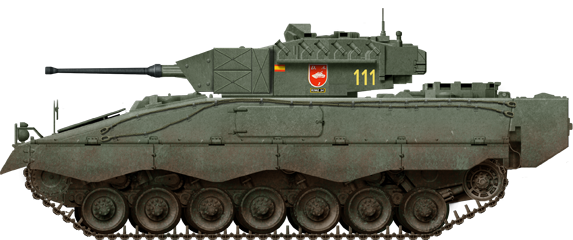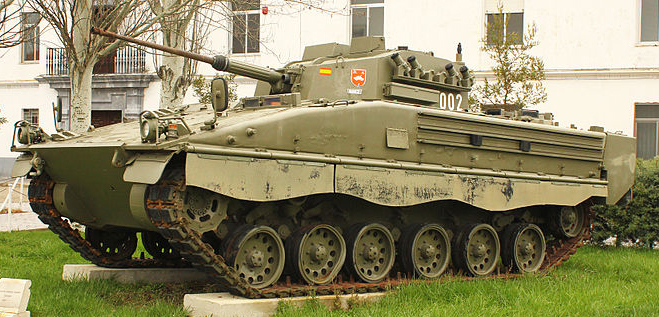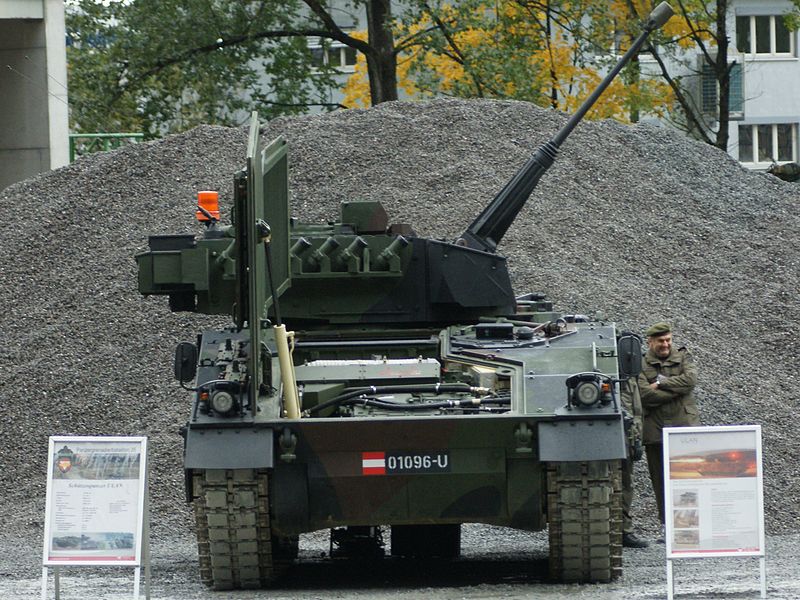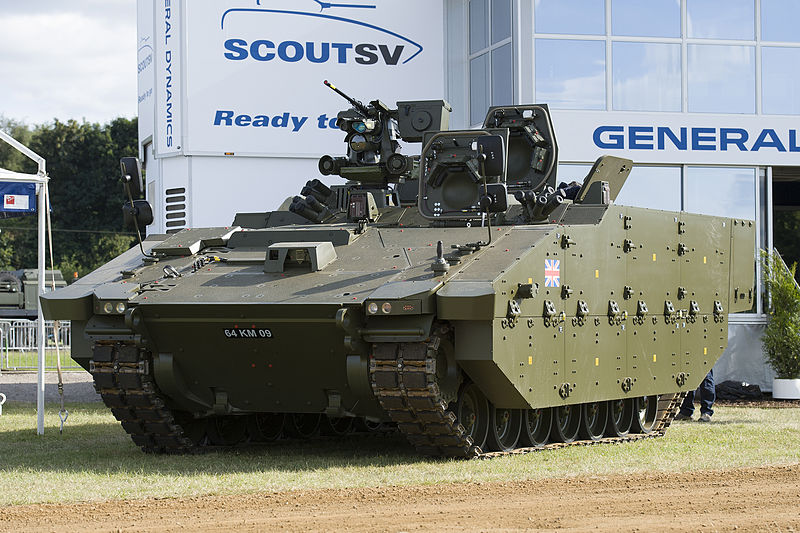Genesis of the ASCOD
The ASCOD acronym stands for Austrian-Spanish Cooperation Development and is one of the most successful cooperation projects in AFV history. In 1980, Infantry Fighting Vehicles (IFVs) were the new trend for defense procurement. Spain and Austria intended to replace their ageing M113 and Saurer APCs. Both countries also operated the German produced Leopard 2s and felt the need for a vehicle that could operate in close cooperation and be deployed quickly for peacekeeping missions worldwide.The Austrian firm Steyr-Daimler-Puch AG had already started working on an IFV design in 1982. This design also interested Norway, Greece, and Switzerland. In 1985, the Bundesheer announced the launch of the Kampfschützenpanzer 90 program. However, development costs exceeded Steyr's budget, and an agreement was sought with Spain and the company Empresa National Santa Barbara S. A. in 1988. This resulted in the creation of the cooperative ASCOD project.
Development
According to the 1988 agreement, Spain was to build the hulls while Austria was to provide the turrets and perform the final assembly. For the hull, Santa Barbara took some inspiration from the German Marder (1971), and Steyr used a derivative of its SP30 turret from the recce version of the Pandur wheeled APC/IFV. The first prototype was delivered by Santa Barbara and presented in 1991 in Seville and was tested the next year. However, it seems protection was insufficient, and many changes were made that brought the total weight from 18.8 t to 25.2 t, and eventually 29 t (an 11 tonnes increase, more than 1/3 of the original weight). In the winter of 1993/94, it was sent to Norway for trials under snowy conditions. A third updated prototype was built following these tests and in 1994, Spain decided to build several machines to test.In 1996, 144 were ordered and the model was officially named the "Pizarro", after the famous conquistador. However, due to financial difficulties, Austria delayed the production of its own version, the Ulan (named after the Austrian light cavalry type) until 1999 and then only made an order for 112. They entered service in 2001. The Pizzaro and Ulan differ in several ways despite being designed congruently.
Design
The ASCOD welded RHA hull is prismatic, with a long front slope covering the engine compartment (right), transmission and driver (left). The fighting compartment follows behind, with the infantry compartment at the rear. The infantry compartment has two roof hatches and a single rear door between the external fuel tanks. The soldier capacity differed between versions: The Pizarro can only carry seven men, while the Ulan carries eight. The two man turret is situated above and to the right of the fighting compartment. This two-man turret is armed with a 30 mm (1.18 in) Mauser MK 30/2 autocannon and coaxial light machine-gun.Protection
The basic hull which has a sloped front, with a 60° inclination, but almost flat sides. Protection is assured on the frontal arc against 14.5 mm (0.57 in) armor-piercing ammunition at 500 m or more (the main armament of the Russian wheeled BTR and BRDMs). Otherwise, protection is sufficient against machine-gun bullets and shrapnel. The Pizarro can receive additional SABBLIR explosive reactive armor modules in order to provide aditional protection against RPGs and shaped charges. The Ulan utilizes the MEXAS composite armor, which can also protect against 30 mm (1.18 in) APFSDS rounds at 1000 m. In addition to the NBC collective system and automatic fire extinguishers in the crew and engine compartments, the ASCOD interiors include spall-liners, as protection against the subsequent shrapnel in case of armor penetration. For active protection, two banks of six smoke projectors are fitted on the turret sides. Smoke projectiles can be swapped for high-explosive and fragmentation grenades, efficient to 50 m (160 ft) around the vehicle.
Schützenpanzer Ulan at full speed
Mobility The Spanish engine is a 600 horsepower (450 kW) MTU SV-183 TE22 engine, while the Austrian model uses a 720 horsepower (540 kW) MTU 8V-199-TE20 engine. Therefore, the power-to-weight ratios are, respectively, 21 and 25 hp/tonne. The latter gives a top speed of 72 km/h (45 mph) on flat ground on average and 35 km/h (20 mph) in reverse. In both cases, a Renk HSWL 106C hydro-mechanical transmission is coupled to the engine. The torsion bar suspension systems and rotary dampers are provided by the Piedrafita company whereas, the tracks are the Diehl type 129. The ASCOD can accelerate from 0 to 50 km/h (30 mph) in 14 seconds, gap a 2.3 m (7 ft 7 in) ditch, climb 95 cm (3'7'' in) walls or ascend a 75% gradient, tackle 40% side slope, or ford 1.2 m (3 ft 11 in).

SPZ Ulan SP30 turret Armament
The armament is concentrated in the SP30 turret. The main weapon is the MK-30/2 gun, a 30 mm (1.18 in) dual belt-fed chain gun. This weapon can fire up to 700 rounds a minute (200 rounds stored in the turret, 205 in the hull) and is electrically stabilized on two planes allowing for accurate fire on the move. The coaxial machine gun is either an MG-3 machine gun (Pizarro) or FN MAG (Ulan). For these, ammunition storage comprises of 600 rounds in the turret and 1,290 in the hull.
The gunner's sight is provided by Elbit, with an 8X magnification day channel. There is also a dual thermal imaging unit with 2.8X and 8.4X magnification (for the gunner and commander). The latter has its own fixed day sight with 8X magnification.
The models differ in that the Ulan sports the digital fire control system built by Kollsman for the Kürassier A2 while the Pizarro uses Indra's Mk-10 model, which integrates a digital ballistic computer, day channel, thermal channel and laser rangefinder.

SPZ Ulan, front view
Variants
The ASCOD was part of the more ambitious CORAZA project and was to be one of a family of vehicles comprising tanks hunters, self-propelled mortars, APCs, armored ambulances, command vehicles, self-propelled artillery, and whatever other roles the military could use this vehicle family for. The main export versions envisioned were scout vehicles and light tanks. In the tank-hunter variant, various commercial turrets were tried with either a 105 mm (4.13 in) or even a smoothbore 120 mm (4.72 in) gun.By the 2000s, both producing companies became branches of General Dynamics, which started developing the ASCOD 2, first presented in 2004 and aimed at the export and upgrade markets. This model was given the 800 hp MTU 8V 199T21 engine, Renk HSWL 256 B transmission and upgraded tracks. Later, two APCs equipped with Rafael RWS were proposed with an urban combat protection kit (ASCOD PSO). In 2008, the GDLES branch, working with KMW in Germany, proposed the 150 mm (5.9 in) Artillery Gun Module (AGM) autonomous artillery system "Donar" based on the ASCOD 2 chassis.
Eventually, in March 2010, the British MoD announced that the ASCOD 2 was chosen for the FRES program, becoming the Ajax multipurpose platform. Regular variants used by both Spain and Austria are the driver training version (fixed superstructure) and scout/recce version fitted with the ISTAR equipment at the rear (no infantry carried).
The LT-105 Light Tank was designed for the export market, armed with a 105 mm or 120 mm gun and enlarged turret. The latter can be originated from either Oto Melara, Cockerill, General Dynamics, or Denel Land Systems. The LT-105 exported to the Royal Thai Marine Corps will use the Denel turret.
Production and exports
So far, 261 Pizarro have been manufactured by Santa Bárbara Sistemas in several batches (144 in 1998-2003, 117 in 2011-2015). 112 Ulans were manufactured by Steyr-Daimler-Puch Spezialfahrzeuge between 2001 and 2005.Links
The ASCOD on WikipediaThe ASCOD on the GDELS website
Video presentation of the ASCOD SV (for the Ajax programme)
ASCOD specifications | |
| Dimensions | 6.83 x3.64 x2.43 m 22'5''x11'11''x8' |
| Total weight, battle ready | 26.3 tons |
| Crew | 3 (driver, commander, gunner) |
| Propulsion | 600-720 hp diesel |
| Suspension | Torsion bars with rotary dampers |
| Speed (road) | 72 km/h (45 mph) |
| Armament | 30 mm (1.18 in) Mauser MK 30/2 MG03 or FN-MAG light machine-gun |
| Armor | Protected against RPG, SCW, 25 mm/14.5/8 mm rounds |
| Total production | 373 from 1998-2005 |

ASCOD Pizarro - definitive version with add-on armor

ASCOD Ulan of the Austrian Army, in the 2000s
Video: General Dynamics promotional
Gallery

Prototype of the Spanish ASCOD from 1992. Notice it only has 6 roadwheels, compared to the 7 on the production vehicles - El Goloso museum.













Modern Tanks
Modern MBTs posters

Denel Bagder (2018)

Type 16 MCV (2016)

Gepard 1A2 last rounds 2011

SANDF

Russian AFVs

Main Battle Tanks

